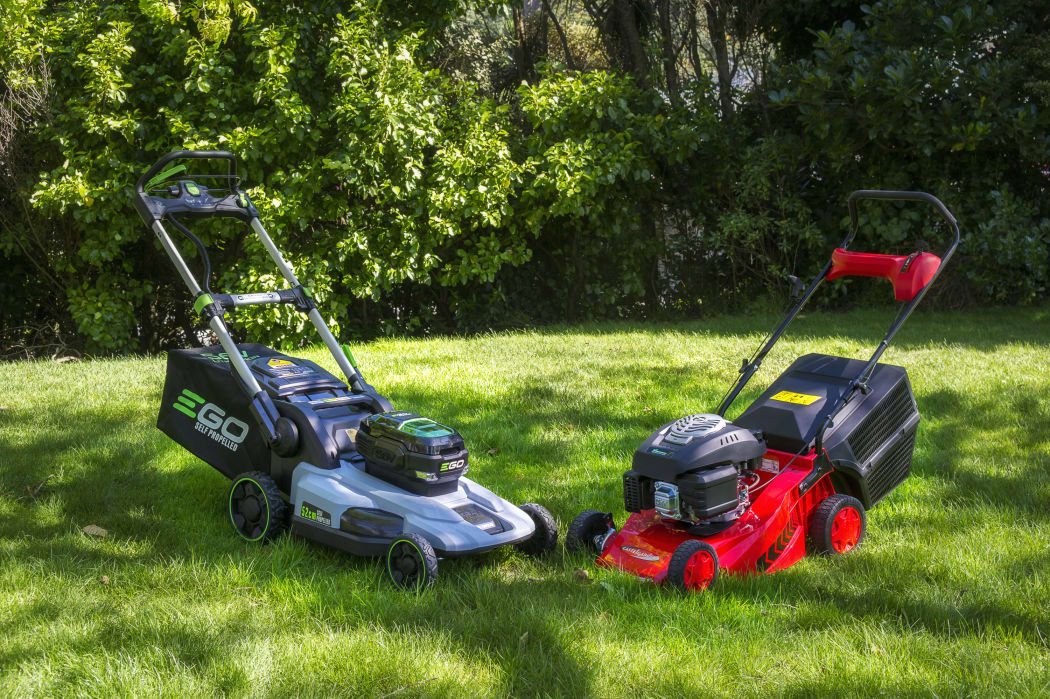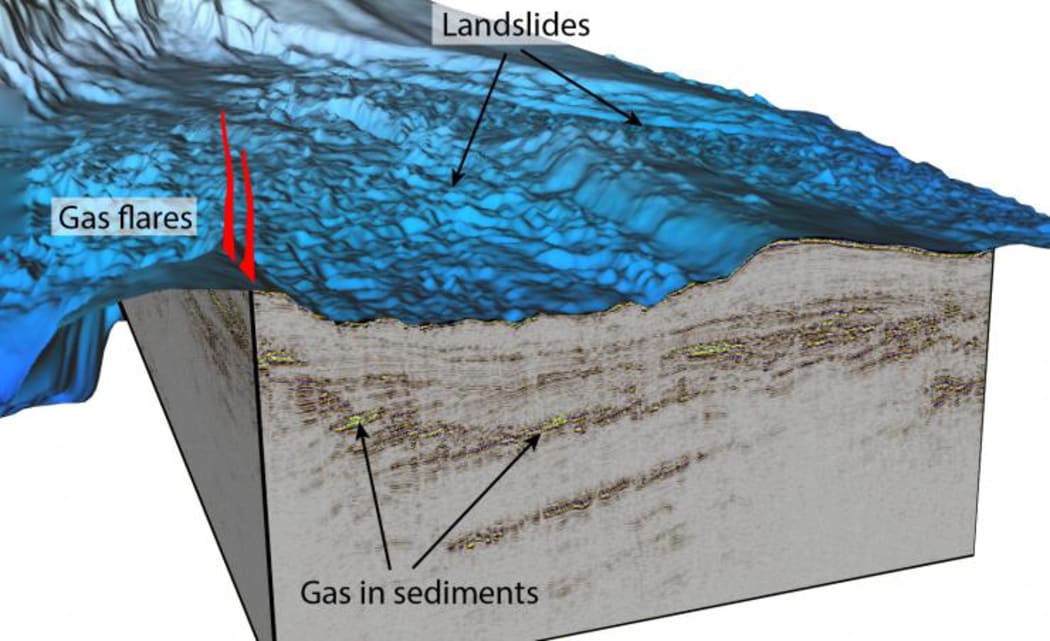This Way Up for Saturday 25 November 2017
This Way Up for Saturday 25 November 2017
A new test for concussion, cloud storage options reviewed, lawnmowers tested, and mining undersea 'fire ice' to conquer Japan's energy woes.
A new test for concussion
There are a few different ways to test for concussion today - most involve a physical examination and then a series of questions. But soon a simple saliva test could rapidly and accurately detect a concussion by measuring genetic changes in the brain after an injury.

2015 Rugby World Cup match New Zealand vs Tonga at St. James’ Park, Newcastle upon Tyne. Photo: (By quintinsmith_ip and crunch, CC BY 2.0)
Diagnosing the concussions that affect thousands of New Zealand sportspeople every year could soon become far more accurate.
Concussions can be tough to diagnose, especially on a busy sideline when the score's close and the competition is fierce. It's not an ideal scenario for working out if someone has had a potentially serious brain injury.
According to ACC figures, in the year to June, there were more than 14,000 accident claims relating to concussion and brain injury here in New Zealand, with about 4,000 of these claims sports related.
There are a few different ways to test for concussion today: most of them involve a physical examination and then a series of questions like "What day is it?...who are you playing against?...what's the score?...and what ground are we at?" But there are concerns these memory-based tests can be subjective and potentially inaccurate.
But soon a simple saliva test could rapidly and accurately detect a concussion by measuring genetic changes in the brain after an injury.
A trial is already underway in England, with Premiership and Championship players rugby players giving saliva samples at the start of the season which are then compared to samples taken when they are injured in a game. The hope is that this study will clear the way for an instant, pitch-side test using a mass-produced, hand-held device.
Meanwhile American researchers have detected the precise chemical biomarkers in saliva that change after a head injury, which could lead to more objective and accurate concussion tests and better treatments. And already people are exploring possible applications to conditions like autism and Parkinson's disease.
Steven Hicks is an assistant professor of pediatrics at Penn State College of Medicine, and one of the authors of the research published this week in the journal JAMA Pediatrics.
Cloud storage options - what's best?
Peter Griffin reviews the best deals on the market for safely storing your data and photos. Who are the main players, who protects your security and privacy best, and why does Apple keep sending alerts that your iCloud is full?
Peter Griffin considers and compares the main players in cloud storage
In the past few years, online storage has become the default place people store their digital stuff - from emails and photos to music and documents.
Storage allowances have become more generous and the services have become easier to use, particularly as smartphone apps allow automatic uploads to the cloud and your content can be “synced” across multiple devices.
Driving this trend is the reduction in cost of online storage as big players like Google, Microsoft and Amazon squeeze better efficiencies from their global networks of data centres.
This means that a handful of players are now hosting a huge chunk of the world’s data. That has implications for security and so-called data sovereignty. But it is also allowing us to more conveniently organise our digital lives and hold onto our digital treasures.
Five things to consider when considering what cloud storage provider to use
-
Pricing: how much storage will you need? Entry level accounts may be offered for free but are there limits on how much data you can transfer per month or the size of files you can send? Can you afford the premium options you will face as you put more stuff in the cloud?
-
Storage priorities: Do you just want raw storage space for dumping stuff in folders or do you want other things such as productivity tools, the ability to collaborate and share files with others?
-
Functionality: Make sure your operating system, mobile devices, preferred browsers and plug-ins are supported.
-
Security: The ‘big five’ providers take security seriously, but some cloud services really tout their encryption and file protection which will be useful if you have precious and sensitive material. Check whether they offer file recovery options and two-factor authentication to reduce the risk of your account being hacked.
-
Exit options: Make sure that data is easily exportable should you want to shift to another provider quickly.
Five tips to keeping your digital stuff secure
-
Get backed up: how would you feel if everything in your Dropbox disappeared? That should be your mindset when considering what to back up somewhere else - either on a local hard drive or another cloud storage provider. Don’t put all of your eggs in one basket.
-
Take security seriously: Put a strong password on your cloud storage account and apply two-factor authentication to make it harder for hackers to access your storage locker. Be careful who you share files with - set expiration dates on sharable download links if possible and be careful with file and folder permissions. Don’t give anyone else the password to your account.
-
Sync carefully: There have been horror stories of people thinking they’ve uploaded files to the cloud and deleting them from their computer only to find they didn’t upload after all. Make sure the two-way links between your devices and your cloud storage account are working.
-
Encrypt: Use a cloud storage operator that encrypts your files before they are transferred over the internet and encrypts them while they are storing them for you. Consider using your encryption tools to secure the files and folders for an extra layer of security.
-
Privacy policies: Read the cloud storage policy fine print. How will your data be used? Will the contents be scanned for keywords to generate adverts targeted at you (a strong possibility if you are using a ‘free’ account).

Photo: (Thomas Kvistholt via unsplash.com)
The five key players in consumer cloud storage
My personal favourite, as it integrates storage with the full suite of Google services I use as productivity tools, including, Gmail, Google Docs, Sheets and Forms.
Excellent search functionality and real-time collaboration on documents is hugely useful. Many organisations use Google’s productivity suite as a free (and some would say more convenient) alternative to Microsoft Office. G-Suite or Google Apps for Work is a package designed specifically with these people in mind.
There are backup and syncing options for PC and Mac and the Google Drive smartphone app is a breeze to use. Google Photo gives you unlimited storage of your photos (with some limitations on image and video size and quality) and operates through a different app. It means you can store all of your photos online without it adding to your Drive storage.
Google Drive advertises itself as “a safe place for all your files”. Google encrypts your data while transferring it to its servers and the data is encrypted while stored on Google’s servers somewhere offshore.
A 15GB account comes free, but there is a price for “free” - as Google outlines in its terms of service.
“Our automated systems analyze your content to provide you personally relevant product features, such as customized search results, and spam and malware detection.”
That doesn’t include tailoring adverts to your needs, according to Google. I consider it a small price to pay.
Price: 15GB: Free, 100GB: $2.99, 1TB*: $14.99, 10TB, $149.99 (all NZ$)
TB = terabyte (1,000 gigabytes)
Probably the go-to option for business users looking for flexible cloud storage options and an easy way to share a download link with collaborators and customers
But the free storage option is very tight - just 2GB. So you’ll really have to be prepared to start paying relatively quickly. Also, I find the interface and way of displaying files frustrating and hard to customise to my needs. The search function isn’t as good as Google’s.
Price: 2GB: Free (can be expanded up to 16GB if you refer other people and share Dropbox sign-up to your social media friends network). 1TB: US$8.25, 1TB: US$16.58 (with additional functionality suited to professionals.)
Microsoft’s rather overlooked cloud storage service. Its key advantage is that it integrates quite nicely into file explorer in Windows 10 and Office 365 - so becomes the online back-end for your office productivity apps like Word and Excel.
It has good photo auto-uploading from your devices to the cloud and a OneDrive account will give you access across the Microsoft empire, from Outlook.com to Xbox Live.
Price: 5GB: Free, 50GB: US$1.99. Options to bundle in subscriptions to Office Home and 1TB of storage for US$69.99 year.
iCloud is the go-to service for those in the Apple world, particularly if you have multiple Apple devices and want to sync your files across all of your devices. That’s everything - text messages, health data from your iWatch, purchase history, call history, purchased ringtones etc.
It has 5GB of storage for free, but as it is intended to be used as your backup solution for all the photos on your phone, your iWork documents, emails etc, you’ll need to move quickly to a premium plan.
It doesn’t have the productivity functionality of Google Drive or OneDrive.
Ultimately, iCloud is of limited use if you don’t live in the Apple world using iOS and Mac OS devices for most of your computing.
But the pricing is very reasonable.
Price: 5GB: Free 50GB: $1.49, 200GB: $4.49, 2TB: $14.99 (all NZ$)
Lesser known in New Zealand as it isn’t tied to players with the same type of marketing muscle, but a large and credible player in the cloud storage space.
It is really aimed at business users and shares similarities with Dropbox, in that there are plenty of tools for sharing files, leaving comments and assigning tasks.
Box has strong privacy and access controls and integrates with business software products such as Salesforce and Netsuite, strengthening the appeal to business.
I find it too complex for my needs.
Price: 10GB: Free, 100GB: US$11.50
Whatever happened to Mega - NZ’s homegrown storage player?
Mega, the creation of controversial internet tycoon Kim Dotcom, is still going and offering some competitive storage options and generous allowances.
There is a free option offering a 50GB storage account - however, in reality, it is only 15GB free, as you need to accrue certain “achievements” such as installing the mobile app, installing MegaSync and referring a friend. Some of these achievements also expire over time.
Otherwise, you are looking at plans starting from $8.60 a month for 200GB, with a 1TB “transfer limit”. That means that you can transfer up to 1TB of data to and from your account each month.
There are 1TB (NZ$17) and 4TB (NZ$35) account options, and a supersized 8TB of storage will cost you NZ$52 a month and you’ll get a 16TB transfer limit.
Mega has a user-friendly user interface that lets you drag and drop files into Mega and sort them into folders.
It has apps for iPhone, Android and Windows Mobile and browser extensions for Firefox and Chrome.
There’s also MegaSync, which like Dropbox, lets you sync files across your devices, keeping local versions of them for offline use.
There are tools for geeks, such as the ability to send large files by email through Mega with the Mozilla Thunderbird mail client.
Security is a big priority for Mega, which was the mantra of founder Kim Dotcom, who no longer has anything to do with the company. Mega has end to end encryption. Mega issues you a recovery key, which is crucial to you being able to access your account if you forget your password - as I discovered when I tried unsuccessfully to log into a mega account I hadn’t used in years:
“Oops.
“Due to our end-to-end encryption paradigm, you will not be able to access your data without either your password or a backup of your Recovery Key.
“You can park your existing account and start a fresh one under the same e-mail address. In the event that you recall your parked account's password, please contact support@mega.nz for recovery assistance. Your data will be retained for at least 60 days.”
All up, a very flexible option for those will large storage needs and who are particularly concerned about security. Doesn’t get much attention among mainstream consumers and if the forums discussing Mega are anything to go by, is very popular with the types of people who made Megaupload such a global phenomenon.
Others worth considering: Look out for specials and discounts - iDrive, SugarSync and also Amazon, which may come onto our radar more if they increase their presence in this part of the world next year.
Cloud storage for photos
By far the best option is Google Photo.
Unlimited free storage (up to 16 megapixel and 1080p quality), syncing tools, excellent tagging and searching of photos. If you aren’t on an Apple device - this is the way to go.
A cut above? Testing lawnmowers
George Block of consumer.org.nz has been testing some new lawnmowers that have recently arrived on the market. He shares his best buys and advice.

Photo: CHRIS COAD
"In general use, cordless models are a good bet, especially if you're keen to wave goodbye to the fumes, noise and hassle of petrol. But if you're an amateur greenkeeper who likes to mow right down to the clover or tackle gnarly, damp or overgrown lawns, then you still can't beat petrol."
"The performance of battery-electric mowers has matured to the point where our annual test finds many nipping at the heels of the best petrol models. They perform just as well in our short- or medium-length grass tests, and they're only a shade behind in our long grass test. They're also lighter and start at the push of a button. However, according to our 2016 appliance reliability survey, Kiwis purchased four times as many petrol push mowers last year than either mains or battery-electric units."
George tests the performance of a new battery mower versus a proven petrol performer here.
You can listen to George's last lawnmower review (from October 2016) below:
The best lawnmower ever?
A buyer's guide to lawnmowers with George Block of consumer.org.nz. And for the first time in 55 years an electric rechargeable mower tops the list, but it will cost you an arm and a leg! Audio, Gallery
Powering Japan: mining undersea 'fire ice'
How can one of the world's leading industrial nations become energy self-sufficient, and avoid paying so much for the fuel imports that cost the economy tens of billions of dollars every year?

Structure of a gas hydrate (methane clathrate) block embedded in the sediment of hydrate ridge, off Oregon, USA. Photo: (By Wusel007 - Own work, CC BY-SA 3.0)
With meagre energy reserves of its own and only a fledgeling interest in renewable power, Japan must import the bulk of its oil, coal and gas from overseas.
But now attention - and government investment - is turning to an untapped natural resource buried deep beneath the seabed.
So-called flammable ice (aka fire ice or methane hydrate) is a mix of water and methane locked away under high pressures and low temperatures in the Arctic permafrost and deep down under the ocean floor.
According to NIWA, there's a huge stash off the East Coast of New Zealand, too.

A 3D image of one section of East Coast seafloor mapped in 3D, complete with methane deposits and flares. Photo: [NIWA]
These methane hydrate reserves have been called the world's largest source of untapped fossil energy, storing more energy than all remaining fossil fuel reserves combined.
But recovering them in a cost-effective way that won't harm the planet is no easy task.
For CNN, Sarah Lazarus has been looking at the prospects and possibilities of flammable ice as an energy source.
"These ice crystals hold a remarkable quantity of natural methane gas. It is estimated that one cubic meter of frozen gas hydrate contains 164 cubic meters of methane. Hold a match to the ice and the gas ignites so that instead of melting, it burns" Sarah Lazarus
"If natural gas could be extracted economically from gas hydrates, it would reshape the energy world. The implications are astounding. The price of natural gas, throughout the world, would be pegged to the price of extracting the hydrates." Professor Christopher Knittel of MIT's Sloan School of Management quoted by Sarah Lazarus

